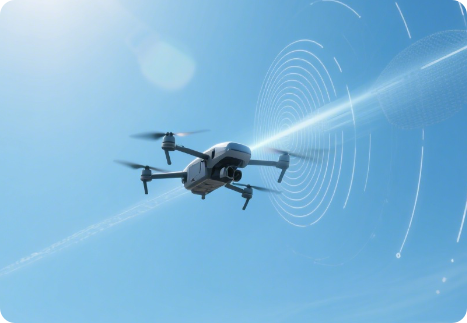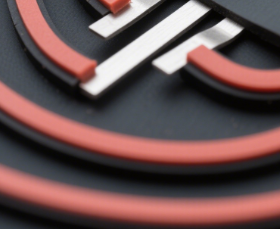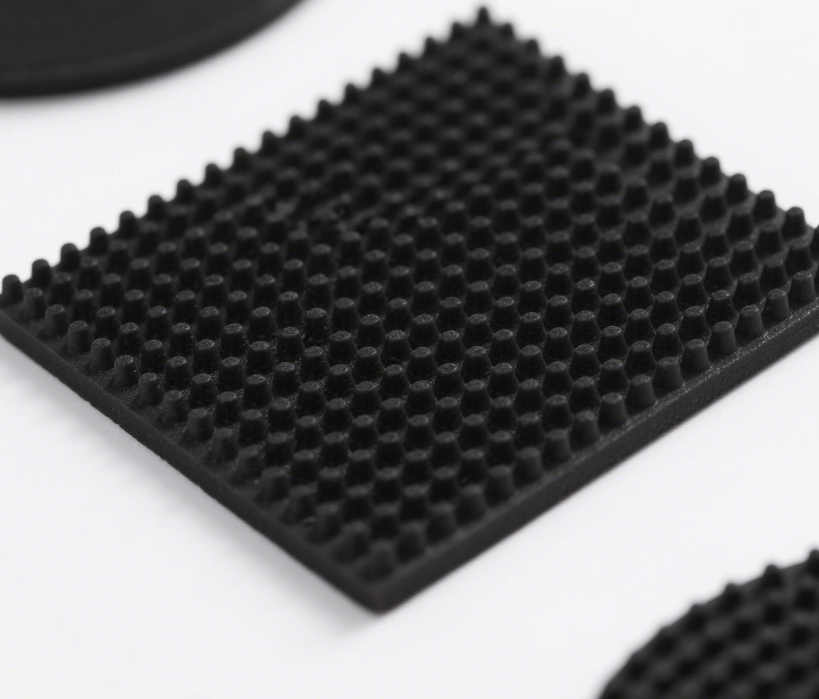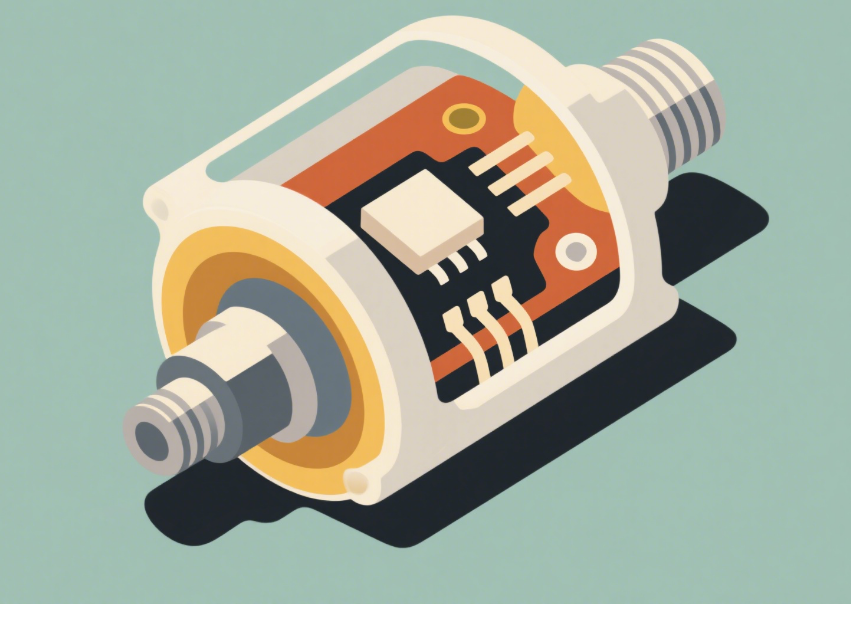Electronic shielding rubber in the Field of Unmanned Aerial Vehicles (UAVs)
2025/06/17
0
1. Introduction
Unmanned Aerial Vehicles (UAVs), commonly known as drones, have witnessed exponential growth in various applications in recent years. From military reconnaissance and surveillance to civilian uses such as aerial photography, delivery services, agricultural monitoring, and infrastructure inspections, UAVs have become an integral part of modern technology.
However, as UAVs are equipped with a plethora of sophisticated electronic components, they are highly susceptible to electromagnetic interference (EMI). EMI can originate from a wide range of sources, both natural and man – made. Natural sources include solar flares, lightning strikes, and cosmic radiation. Man – made sources are even more diverse and prevalent, such as radio frequency (RF) emissions from communication towers, radar systems, power lines, and the electronic components within the UAV itself, like motors and circuit boards.
The consequences of EMI on UAVs can be severe. It can disrupt the communication links between the UAV and its operator, interfere with the navigation systems (such as GPS), and cause malfunctions in the flight control systems. In extreme cases, EMI can lead to the loss of control of the UAV, resulting in crashes and potential damage to property or even endangerment of lives.
2. The Need for Electronic Shielding in UAVs
2.1 Impact of EMI on UAV Systems
2.1.1 Communication Disruptions
UAVs rely heavily on wireless communication for command and control. Whether it is a simple remote – controlled quadcopter for hobbyist use or a complex military UAV for strategic operations, a stable communication link is crucial. EMI can distort or block the communication signals, leading to delays in receiving commands or transmitting data. For example, in a delivery UAV operation, if the communication is disrupted due to EMI, the UAV may not be able to receive the correct delivery location coordinates, causing it to miss the target.
2.1.2 Navigation Errors
Most UAVs use GPS for navigation. EMI can interfere with the weak GPS signals, causing inaccuracies in the UAV’s position determination. A UAV used for precision agriculture mapping that experiences GPS interference may provide incorrect data about the crop health and soil conditions, leading to ineffective farming decisions. In military applications, inaccurate navigation due to EMI can cause a UAV to deviate from its intended mission path, potentially compromising the mission’s success.
2.1.3 Flight Control Malfunctions
The flight control system of a UAV is responsible for maintaining its stability and performing maneuvers. EMI can disrupt the signals sent from the flight controller to the motors and other actuators. A small multi – rotor UAV may experience erratic flight behavior, such as sudden yawing or pitching, if its flight control system is affected by EMI. In larger fixed – wing UAVs, EMI – induced malfunctions in the flight control system can be even more dangerous, as they may be operating at higher altitudes and speeds.
2.2 Requirements for Shielding Materials in UAVs
Given the critical nature of UAV operations and the potential threats posed by EMI, the shielding materials used in UAVs must meet several stringent requirements.
2.2.1 High Shielding Effectiveness
The primary function of an electronic shielding material is to attenuate electromagnetic fields. In the context of UAVs, the shielding material needs to provide high shielding effectiveness (SE) over a wide frequency range. This is because UAVs are exposed to EMI from various sources, which can emit electromagnetic waves at different frequencies, from low – frequency power line interference to high – frequency RF emissions from communication devices. A material with high SE can effectively reduce the intensity of the incoming EMI, protecting the sensitive electronic components inside the UAV.
2.2.2 Lightweight
Weight is a crucial factor in UAV design. Since UAVs are powered by batteries or limited – capacity fuel sources, minimizing weight is essential to extend flight time and increase payload capacity. Electronic shielding materials used in UAVs must be lightweight to avoid adding excessive mass. For example, a delivery UAV needs to carry packages, and any additional weight from the shielding material will reduce the amount of cargo it can transport or shorten its flight range.
2.2.3 Flexibility and Durability
UAVs are subject to various mechanical stresses during flight, such as vibrations, impacts, and temperature – induced expansions and contractions. The shielding material should be flexible enough to withstand these mechanical stresses without cracking or losing its shielding properties. Additionally, it must be durable to resist environmental factors like moisture, UV radiation, and chemical exposure. A flexible and durable shielding material will ensure the long – term reliability of the UAV’s EMI protection, especially for UAVs operating in harsh environments, such as those used for coastal surveillance or in industrial areas.
3. Electronic Shielding Rubber: Properties and Working Principle
3.1 Composition and Structure of Electronic Shielding Rubber
Electronic shielding rubber is a specialized type of rubber material that has been engineered to possess electromagnetic shielding capabilities. It is typically composed of a rubber matrix and conductive fillers.
3.1.1 Rubber Matrix
The rubber matrix serves as the base material, providing the material with flexibility, elasticity, and resilience. Common types of rubber used in shielding rubber include silicone rubber, fluorosilicone rubber, and nitrile rubber. Silicone rubber, for example, is widely preferred due to its excellent high – temperature and low – temperature resistance, good electrical insulation properties in its non – conductive state, and its ability to maintain its physical properties over a wide temperature range. Fluorosilicone rubber offers enhanced resistance to fuels, oils, and chemicals, making it suitable for UAVs operating in environments where such substances may be present.
3.1.2 Conductive Fillers
To impart electromagnetic shielding properties, the rubber matrix is filled with conductive particles. These conductive fillers can be metals (such as silver, copper, nickel), metal – coated particles (e.g., silver – coated glass beads), or conductive carbon – based materials (like carbon black or graphite). The choice of conductive filler depends on various factors, including the desired shielding effectiveness, cost, and compatibility with the rubber matrix. For instance, silver – based fillers offer high electrical conductivity and excellent shielding performance but are relatively expensive. Nickel – based fillers, on the other hand, are more cost – effective and have good corrosion resistance, making them suitable for applications where cost is a significant consideration.
The conductive fillers are dispersed within the rubber matrix to form a conductive network. When the rubber is in its cured state, these conductive particles are in contact with each other or are close enough to allow the flow of electric current through the material when an electromagnetic field is applied.
3.2 Working Principle of Electromagnetic Shielding
The working principle of electronic shielding rubber is based on two main mechanisms: reflection and absorption of electromagnetic waves.
3.2.1 Reflection
When an electromagnetic wave encounters the surface of the electronic shielding rubber, a portion of the wave is reflected back due to the difference in electrical properties (impedance) between the air (or the medium through which the wave is traveling) and the conductive shielding rubber. The conductive network within the rubber acts as a barrier to the electromagnetic wave. The free electrons in the conductive fillers respond to the oscillating electric field of the electromagnetic wave, causing them to move. This movement of electrons generates an opposing electromagnetic field, which reflects a significant part of the incident wave back into the original medium. The higher the electrical conductivity of the shielding rubber, the more efficient the reflection process.
3.2.2 Absorption
In addition to reflection, electronic shielding rubber also absorbs a portion of the electromagnetic wave. As the electromagnetic wave penetrates the shielding rubber, the conductive network within the material causes the electric and magnetic fields of the wave to interact with the electrons in the conductive fillers. This interaction dissipates the energy of the electromagnetic wave as heat. The conductive fillers, especially those with high resistivity or magnetic properties (such as certain types of carbon – based fillers or magnetic metal particles), are effective in converting the electromagnetic energy into heat. The absorbed energy is then dissipated within the rubber matrix, reducing the intensity of the electromagnetic wave that passes through the material.
Overall, the combination of reflection and absorption mechanisms in electronic shielding rubber enables it to provide effective attenuation of electromagnetic fields, protecting the electronic components inside the UAV from EMI.
4. Applications of Electronic Shielding Rubber in UAVs
4.1 Protection of Electronic Components
4.1.1 Printed Circuit Boards (PCBs)
PCBs are the backbone of a UAV’s electronic system, housing various components such as microcontrollers, sensors, and communication modules. Electronic shielding rubber can be used to create a shielding enclosure around the PCB. By placing the shielding rubber around the edges of the PCB or using it to fill the gaps between the PCB and its housing, it can prevent external EMI from reaching the sensitive components on the PCB. For example, in a UAV’s flight control PCB, which is responsible for processing critical flight – related data, shielding rubber can protect it from EMI that could otherwise disrupt the data processing and control signals.
4.1.2 Sensors
UAVs are equipped with a wide range of sensors, including accelerometers, gyroscopes, magnetometers, and cameras. These sensors are highly sensitive to electromagnetic interference. Electronic shielding rubber can be used to shield individual sensors or sensor modules. For instance, a magnetometer, which is crucial for determining the UAV’s orientation, can be shielded with a custom – made shielding rubber cover. This cover will prevent external magnetic fields from interfering with the magnetometer’s readings, ensuring accurate orientation data for the UAV’s flight control system.
4.2 Sealing and EMI Shielding in Enclosures
4.2.1 Equipment Enclosures
UAVs have multiple equipment enclosures that house different subsystems, such as the battery compartment, communication equipment, and power electronics. These enclosures need to be sealed to protect the internal components from environmental factors like dust, moisture, and mechanical impacts. At the same time, they must also provide EMI shielding. Electronic shielding rubber gaskets are commonly used for this purpose. These gaskets are placed between the mating surfaces of the enclosure parts. When the enclosure is closed, the shielding rubber gasket is compressed, creating a seal that not only prevents the ingress of environmental contaminants but also blocks electromagnetic waves from entering or exiting the enclosure. For example, in a UAV’s communication equipment enclosure, a high – quality shielding rubber gasket can ensure that the sensitive communication modules inside are protected from both environmental damage and EMI, maintaining reliable communication with the ground station.
4.2.2 Antenna Enclosures
Antennas are critical components for UAV communication and navigation. However, they are also vulnerable to EMI. Electronic shielding rubber can be used in antenna enclosures to protect the antenna elements from external EMI while allowing the desired electromagnetic waves to be transmitted and received. A shielding rubber cover or gasket around the antenna enclosure can prevent interference from other electronic devices on the UAV or from external sources. Additionally, the shielding rubber can help to improve the antenna’s radiation pattern by reducing unwanted reflections and interference, enhancing the overall communication and navigation performance of the UAV.
4.3 Cable and Connector Shielding
4.3.1 Wiring Harnesses
UAVs have a complex network of wiring harnesses that carry power and signals between different components. These wires can act as antennas, picking up EMI from the surrounding environment and transmitting it to sensitive components. Electronic shielding rubber can be used to shield the wiring harnesses. This can be done by using shielding rubber sleeves or tapes that are wrapped around the wires. The conductive properties of the shielding rubber prevent the EMI from coupling onto the wires, ensuring that the signals and power are transmitted cleanly. For example, in the wiring harness that connects the UAV’s battery to its motors, a shielding rubber sleeve can protect against EMI that could otherwise cause voltage fluctuations and affect the motor’s performance.
4.3.2 Connectors
Connectors are points of potential vulnerability for EMI ingress and egress. Electronic shielding rubber can be used in connector designs to provide both electrical connection and EMI shielding. Shielding rubber grommets or inserts can be placed around the connectors to ensure that the gaps between the connector parts are filled and shielded. This helps to maintain the integrity of the signal transmission through the connectors and prevent EMI from leaking in or out. In a UAV’s data transfer connectors, which are used to transmit high – speed data between different modules, shielding rubber connectors can prevent data corruption due to EMI interference.
5. Types of Electronic Shielding Rubber for UAV Applications
5.1 Silicone – Based Shielding Rubber
5.1.1 Properties and Advantages
Silicone – based shielding rubber is one of the most widely used types in UAV applications. It offers several advantages. Firstly, it has excellent thermal stability, with a working temperature range typically from – 50°C to 200°C, which is well – suited for the various environmental conditions that UAVs may encounter. Secondly, silicone rubber has good electrical insulation properties in its base form, which can be modified by adding conductive fillers to achieve the desired shielding effectiveness. It also has high flexibility and elasticity, allowing it to conform to different shapes and sizes of UAV components. Additionally, silicone rubber is resistant to moisture, UV radiation, and many chemicals, making it durable for long – term use in different environments.
5.1.2 Applications in UAVs
In UAVs, silicone – based shielding rubber is commonly used in applications such as sealing and shielding of electronic enclosures, protecting PCBs, and cable shielding. For example, in the battery enclosure of a UAV, a silicone – based shielding rubber gasket can provide both a waterproof and EMI – shielding seal. The high flexibility of the silicone rubber allows it to form a tight seal even when the enclosure may experience some mechanical stress during flight. In cable shielding, silicone – based shielding rubber sleeves can be easily installed around wires due to their flexibility, and they can effectively protect the wires from EMI interference.
5.2 Fluorosilicone – Based Shielding Rubber
5.2.1 Properties and Advantages
Fluorosilicone – based shielding rubber is a specialized variant that offers enhanced chemical resistance compared to regular silicone rubber. It is highly resistant to fuels, oils, and solvents, which makes it particularly suitable for UAVs operating in environments where exposure to such substances is likely, such as near fuel storage areas or in industrial settings. Fluorosilicone rubber also has good thermal stability, with a working temperature range similar to that of silicone rubber. In terms of electromagnetic shielding, it can be filled with appropriate conductive fillers to achieve high shielding effectiveness.
5.2.2 Applications in UAVs
UAVs used in military operations, especially those that may be exposed to fuel – rich environments or chemical warfare agents, often utilize fluorosilicone – based shielding rubber. For example, in the enclosures of UAVs used for refueling operations or in areas with potential chemical contamination, fluorosilicone – based shielding rubber gaskets can provide reliable protection against both EMI and chemical exposure. In UAVs equipped with fuel – powered engines, fluorosilicone – based shielding rubber can be used to shield the engine control electronics from EMI while also protecting them from fuel vapors and other chemical by – products.
5.3 Nitrile – Based Shielding Rubber
5.3.1 Properties and Advantages
Nitrile – based shielding rubber is known for its excellent oil and fuel resistance, similar to fluorosilicone rubber. It also has good mechanical properties, such as high tensile strength and abrasion resistance. Nitrile rubber can be compounded with conductive fillers to create shielding rubber with effective EMI attenuation capabilities. It is relatively cost – effective compared to some other specialized shielding rubbers, making it an attractive option for applications where cost is a significant consideration without sacrificing too much on performance.
5.3.2 Applications in UAVs
In UAVs used for agricultural spraying or in industrial inspection where they may come into contact with oils, lubricants, or other chemicals, nitrile – based shielding rubber can be used. For example, in the enclosures of UAVs used for spraying pesticides in farms, nitrile – based shielding rubber gaskets can protect the internal electronics from both EMI and the chemical pesticides. In UAVs used for inspecting industrial machinery, the abrasion – resistant property of nitrile – based shielding rubber can be beneficial in protecting the UAV’s components from mechanical wear while providing EMI shielding.
6. Design Considerations for Using Electronic Shielding Rubber in UAVs
6.1 Shielding Effectiveness and Frequency Range
6.1.1 Assessing Shielding Requirements
Before selecting an electronic shielding rubber for a UAV application, it is essential to accurately assess the shielding requirements. This involves determining the frequency range of the expected EMI sources. Different UAV applications may be exposed to different frequency bands of EMI. For example, a UAV used in a wireless communication – intensive area may be more exposed to high – frequency RF emissions in the GHz range, while a UAV operating near power lines may be more affected by low – frequency EMI in the kHz range. By understanding the frequency spectrum of the EMI, the appropriate type of shielding rubber with the right combination of conductive fillers and rubber matrix can be chosen to provide the required shielding effectiveness at those frequencies.
6.1.2 Selecting the Right Material for the Frequency Range
Some shielding rubbers are more effective at certain frequency ranges. For low – frequency EMI, materials with high – permeability conductive fillers, such as nickel – based fillers, may be more suitable as they can enhance the absorption of low – frequency magnetic fields. For high – frequency EMI, materials with high – conductivity fillers like silver – based fillers are often preferred as they can more effectively reflect the high – frequency electromagnetic waves. Additionally, the thickness of the shielding rubber can also affect its performance at different frequencies. Thicker shielding rubber may be required for lower – frequency EMI shielding, while thinner layers may be sufficient for high – frequency applications.
6.2 Compatibility with UAV Materials and Structures
6.2.1 Material Compatibility
Electronic shielding rubber needs to be compatible with the other materials used in the UAV. This includes compatibility with the plastics, composites, and metals that make up the UAV’s structure and components. For example, if the UAV’s airframe is made of a carbon fiber composite, the shielding rubber should not cause any chemical reactions or degradation of the composite material. Compatibility is also important in terms of adhesion. The shielding rubber should be able to adhere well to the surfaces it is intended to shield, whether it is a plastic enclosure or a metal – plated component.

















